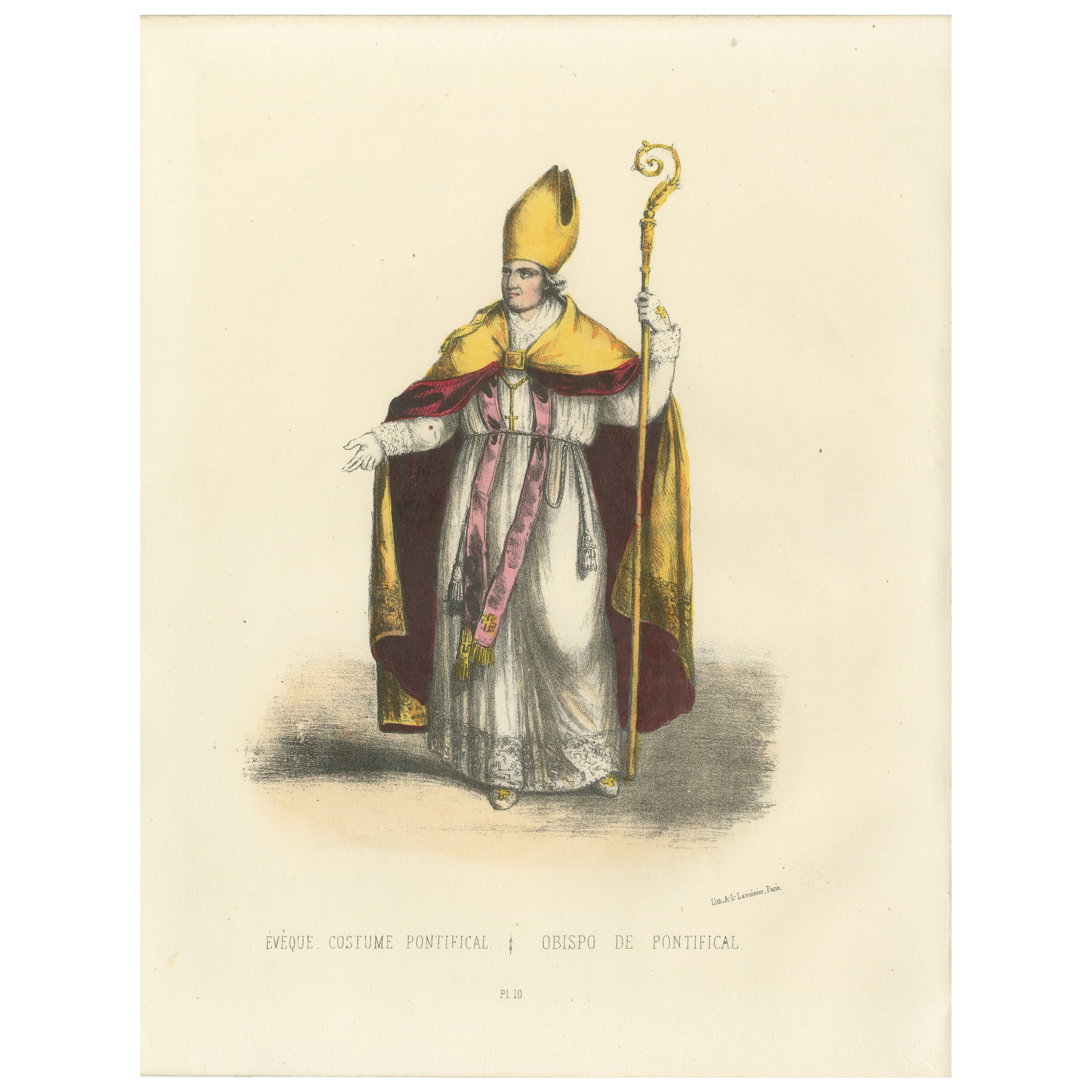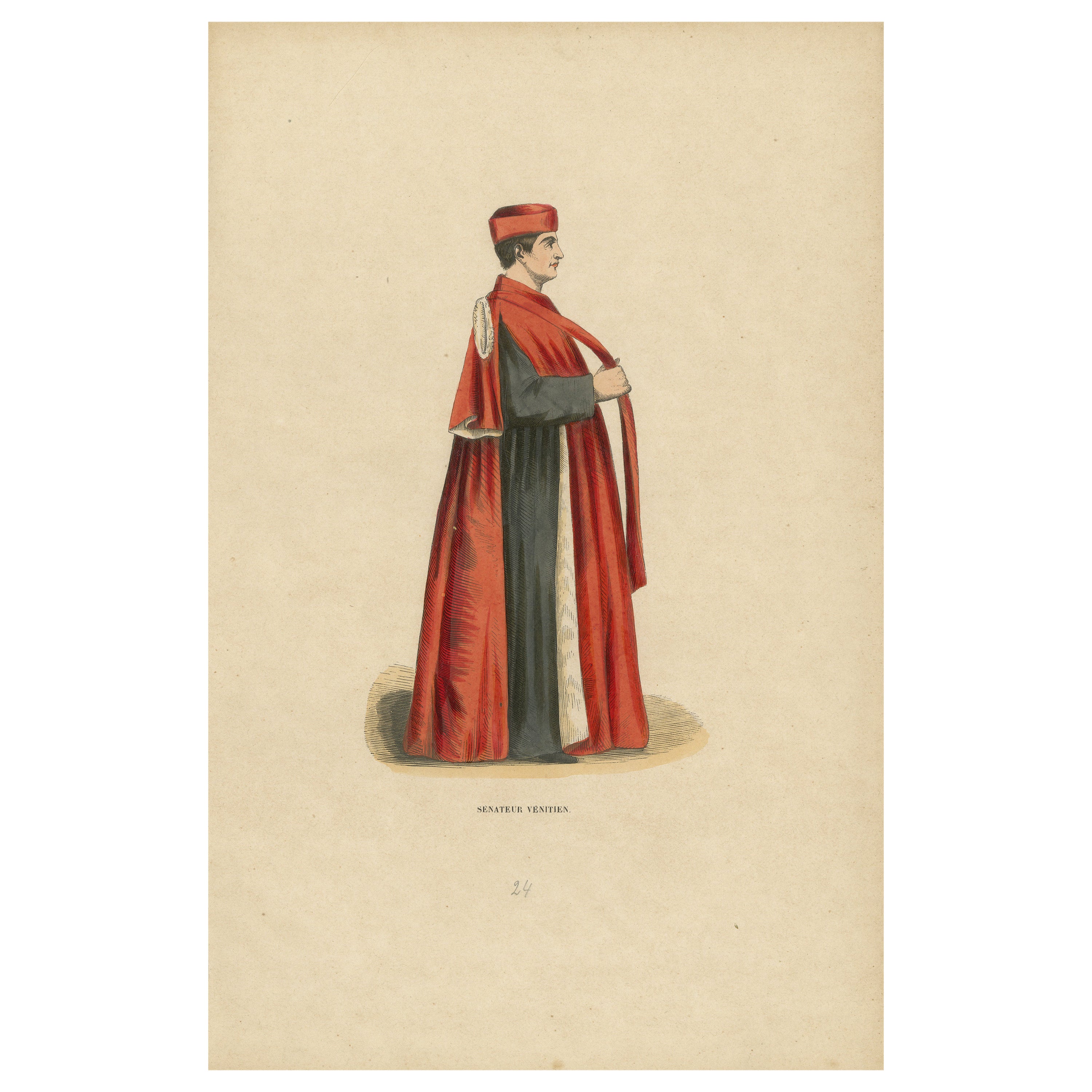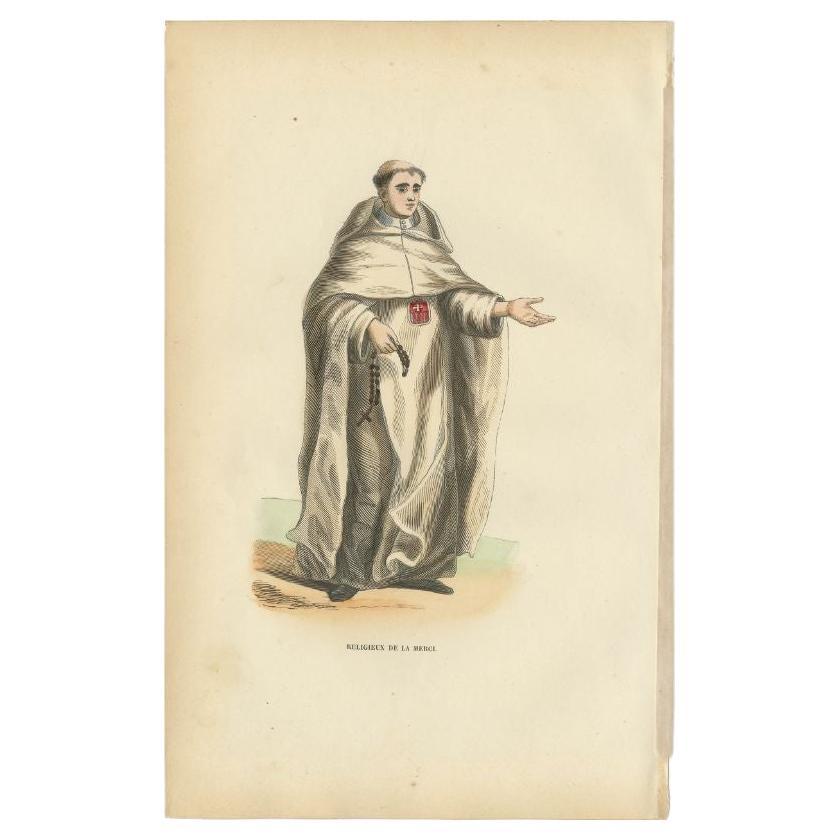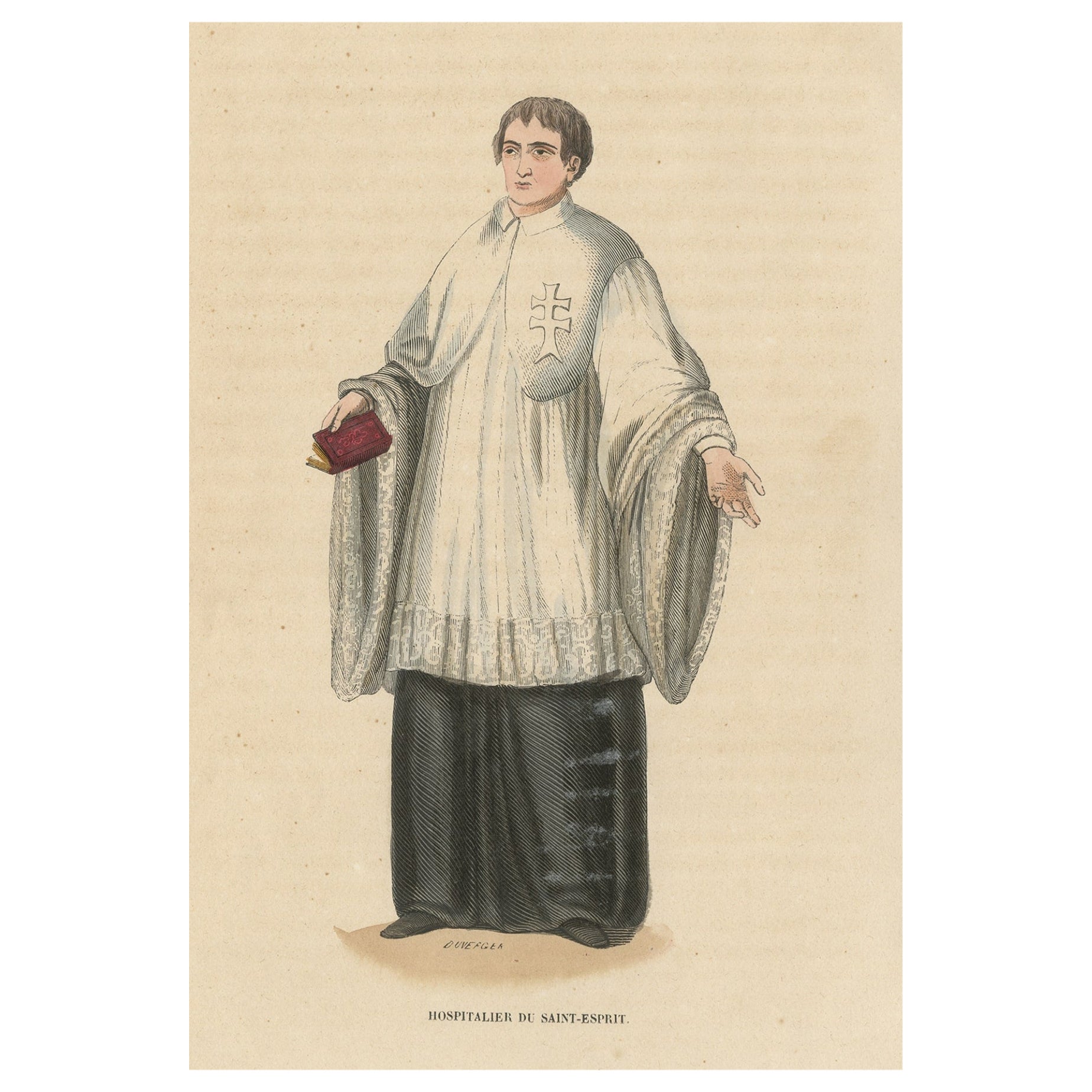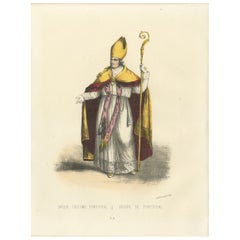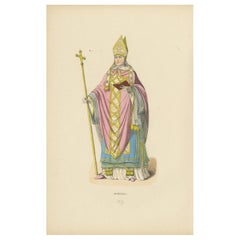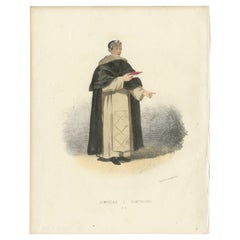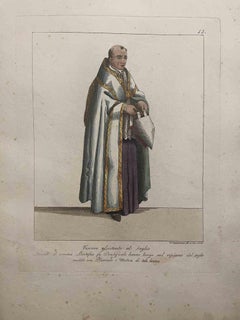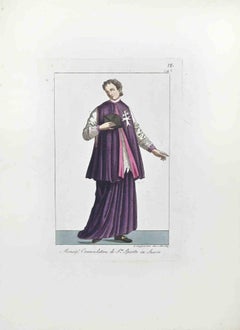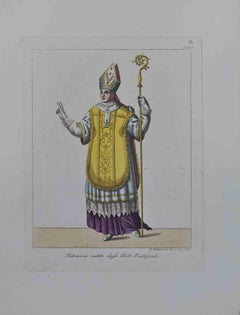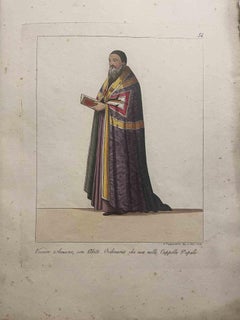Items Similar to Clerical Dignity: An English Priest in 'Costume du Moyen Âge', 1847
Want more images or videos?
Request additional images or videos from the seller
1 of 6
Clerical Dignity: An English Priest in 'Costume du Moyen Âge', 1847
$170.13
$212.6620% Off
£127.52
£159.4020% Off
€144
€18020% Off
CA$233.73
CA$292.1620% Off
A$260.94
A$326.1720% Off
CHF 136.73
CHF 170.9120% Off
MX$3,194.11
MX$3,992.6420% Off
NOK 1,736.43
NOK 2,170.5420% Off
SEK 1,637.23
SEK 2,046.5420% Off
DKK 1,096.18
DKK 1,370.2320% Off
Shipping
Retrieving quote...The 1stDibs Promise:
Authenticity Guarantee,
Money-Back Guarantee,
24-Hour Cancellation
About the Item
Title: "Clerical Dignity: An English Priest in 'Costume du Moyen Âge'"
Description: This lithograph, part of the "Costume du Moyen Âge" series from 1847, depicts an English priest adorned in his ecclesiastical robes. The illustration captures the respect and authority of his clerical office through the meticulous portrayal of his vestments. The priest is wearing a chasuble, the outermost liturgical vestment, which is a rich crimson, signifying the blood of Christ and the sacrifice of the martyrs. It is adorned with intricate yellow patterns, possibly indicative of the specific liturgical season or feast day.
Beneath the chasuble, the priest wears an alb, a long white garment that reaches his feet, representing purity. Around his neck, there is a clerical collar, and his wrists are adorned with cuffs that are likely part of an amice, a liturgical vestment worn under the chasuble.
The stole, a band of cloth that signifies the priest's ordination and authority to perform sacraments, drapes across his shoulders and down the front of the chasuble, embellished with decorative motifs.
In his hands, he holds a chalice, ready for the celebration of the Eucharist, the central rite of Christian worship. His posture is upright and solemn, reflecting the gravity and devotion associated with his religious duties.
His feet are clad in red shoes, peeking out from beneath the hem of the alb, which may be symbolic of the readiness to spread the gospel. The priest's facial features are rendered with a sense of serenity and thoughtfulness, appropriate for a man of his spiritual calling.
This lithograph not only provides a visual record of the vestments of an English priest during the Middle Ages but also conveys the reverence and solemnity associated with the clerical profession at the time. The image is a celebration of the historical tradition of clerical dress, highlighting its significance in the cultural and spiritual life of the era.
The colors have a nice glow over them. Historically, egg whites, known as glair, and sometimes egg yolk were indeed used in illumination and painting, particularly in manuscripts, to give colors a brighter appearance and to add a sheen or gloss to the work. This technique was quite common during the Middle Ages and into the Renaissance.
Egg whites can be applied as a varnish over pigments to enhance their brightness and to protect the colors. This application could make the colors appear more vivid and also add a slight glossy sheen to the surface of the image.
Egg yolk, on the other hand, was commonly used as a binding agent in paint. It forms the basis of tempera paint, a medium that was widely used before the advent of oil painting. Egg yolk helps to create a durable and long-lasting color that adheres well to various surfaces.
In the context of the print from 1847, it's less likely that egg whites or yolks were used directly on the print, as by that time, commercial printing processes would have been more advanced and less reliant on such manual methods. However, if this print is a representation of an earlier style or is meant to mimic the appearance of hand-painted manuscripts, the original artists might have employed techniques or materials that gave a similar effect to those achieved with egg-based binders and varnishes.
- Dimensions:Height: 10.63 in (27 cm)Width: 7.09 in (18 cm)Depth: 0 in (0.02 mm)
- Materials and Techniques:
- Period:
- Date of Manufacture:1847
- Condition:Good. Overal light toning and light soiling but the image itself clean and hand-colored almost 200 years ago and still in expliciet colors. Aged paper with typically warm, yellowish-brown hue, mostly around the edges. Study the images carefully.
- Seller Location:Langweer, NL
- Reference Number:Seller: BG-13635-1291stDibs: LU3054337928742
About the Seller
5.0
Recognized Seller
These prestigious sellers are industry leaders and represent the highest echelon for item quality and design.
Platinum Seller
Premium sellers with a 4.7+ rating and 24-hour response times
Established in 2009
1stDibs seller since 2017
2,511 sales on 1stDibs
Typical response time: <1 hour
- ShippingRetrieving quote...Shipping from: Langweer, Netherlands
- Return Policy
Authenticity Guarantee
In the unlikely event there’s an issue with an item’s authenticity, contact us within 1 year for a full refund. DetailsMoney-Back Guarantee
If your item is not as described, is damaged in transit, or does not arrive, contact us within 7 days for a full refund. Details24-Hour Cancellation
You have a 24-hour grace period in which to reconsider your purchase, with no questions asked.Vetted Professional Sellers
Our world-class sellers must adhere to strict standards for service and quality, maintaining the integrity of our listings.Price-Match Guarantee
If you find that a seller listed the same item for a lower price elsewhere, we’ll match it.Trusted Global Delivery
Our best-in-class carrier network provides specialized shipping options worldwide, including custom delivery.More From This Seller
View AllLithograph of Évêque en Costume Pontifical (Bishop in Pontifical Robes), 1862
Located in Langweer, NL
Handcolored Lithograph of Évêque en Costume Pontifical (Bishop in Pontifical Robes), Plate 10, 1862
A stunning handcolored lithograph portraying an Évêque en Costume Pontifical (...
Category
Antique 1860s Prints
Materials
Paper
In Council and Commerce: A Venetian Senator in Robes of Office, 1847
Located in Langweer, NL
The image portrays a figure labeled "Sénateur Vénitien," which translates to "Venetian Senator." The Venetian senator is shown in a profile view, wearing traditional senatorial robes...
Category
Antique 1840s Prints
Materials
Paper
$151 Sale Price
20% Off
Ecclesiastical Splendor: The Archbishop's Regalia in a Lithograph of 1847
Located in Langweer, NL
Title: "Ecclesiastical Splendor: The Archbishop's Regalia in 'Costume du Moyen Âge'"
Description: This historically rich lithograph from the 1847 edition of "Costume du Moyen Âge" d...
Category
Antique 1840s Prints
Materials
Paper
$160 Sale Price
20% Off
Dominican Friar: A Portrait of Scholarly Devotion and Preaching, 1862 Lithograph
Located in Langweer, NL
Dominican Friar: A Portrait of Scholarly Devotion and Preaching, Plate 53
This finely detailed lithograph illustrates a Dominican friar, clad in the traditional black cappa and wh...
Category
Antique 1860s Prints
Materials
Paper
Antique Print of a Monk of the Order of La-Merci, 1845
Located in Langweer, NL
Antique print titled 'Religieux de la Merci'. Print of a Monk of the Order of La-Merci. This print originates from 'Histoire et Costumes des Ordres Religieux'.
Artists and Engrave...
Category
Antique 19th Century Prints
Materials
Paper
$170 Sale Price
20% Off
Hospitaler of the Order of the Holy Ghost, Roman Catholic Order, 1845
Located in Langweer, NL
Antique print titled 'Hospitalier du Saint-Esprit'.
Print of a Hospitaler of the Order of the Holy Ghost, Hospitallers of the Holy Spirit, Roman Catholi...
Category
Antique 1840s Prints
Materials
Paper
$226 Sale Price
20% Off
You May Also Like
The Bishop Assistant at the Pontifical... - Etching by Giuseppe Capparoni - 1828
Located in Roma, IT
The Bishop Assistant at the Pontifical Throne is an Artwork realized in 1828 by the Engraver, Giuseppe Capparoni (Rome 1800- 1879).
Etching hand colored on ivory paper. Signed on pl...
Category
1820s Modern Portrait Prints
Materials
Etching
The Monsignor of "Santo Spirito in Sassia"- Etching by Giuseppe Capparoni - 1827
Located in Roma, IT
The Monsignor of "Santo Spirito in Sassia" is an Artwork realized in 1827 by the Engraver, Giuseppe Capparoni (Rome 1800- 1879).
Etching hand colored on ivory paper. Signed on plate...
Category
1820s Modern Portrait Prints
Materials
Etching
The Patriarch Dressed with Papal Clothes - Etching by Giuseppe Capparoni - 1828
Located in Roma, IT
The artwork belongs to the "Gerarchia ecclesiastica considerata nelle vesti sagre e civili usate da quelli li quali la compongono", composed by 112 engraved and hand-colored tables, ...
Category
1820s Modern Portrait Prints
Materials
Etching
Armenian Bishop - Etching by Giuseppe Capparoni - 1828
Located in Roma, IT
Armenian Bishop is an Artwork realized in 1828 by the Engraver, Giuseppe Capparoni (Rome 1800- 1879).
Etching hand colored on ivory paper. Signed on plate and dated on the right mar...
Category
1820s Modern Portrait Prints
Materials
Etching
The Cardinal - Etching by Giuseppe Capparoni - 1828
Located in Roma, IT
The Cardinal is an Artwork realized in 1828 by the Engraver, Giuseppe Capparoni (Rome 1800- 1879).
Etching hand colored on ivory paper. Signed on plate and dated on the right margin...
Category
1820s Modern Portrait Prints
Materials
Etching
The Bishop - Etching by Giuseppe Capparoni - 1828
Located in Roma, IT
The Bishop is an Artwork realized in 1828 by the Engraver, Giuseppe Capparoni (Rome 1800- 1879).
Etching hand colored on ivory paper. Signed on plate and dated on the right margin....
Category
1820s Modern Portrait Prints
Materials
Etching
More Ways To Browse
Antique Chasuble
Art Deco Glass Shelving
Astronomical Clock
Baker New World Collection
Baroque Headboard
Bear Bookends
Bi Discs
Birds Of Paradise China
Black Cerused Dining Table
Black Iron Beds
Black Victorian Bed
Blanket Chest Dome
Boston Sculpture Company
Boston Terrier
Bow Front Glass Cabinet
Brass Antelope
Brass Crane Bird
Brass Elephant Tusks
